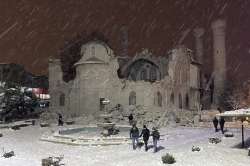EXPLAINED: Why Turkey is prone to deadliest earthquakes in the world; lessons to be learnt
Turkey has a history of some deadly quakes that killed more than 20,000 at once. Know all the reasons.

Turkey earthquake: Turkey witnessed one of the most powerful earthquakes in the past two decades on Monday, with more than 1,300 people killed and thousands still believed to be trapped under rubble. According to the United States Geological Survey (USGS), a 7.8 magnitude earthquake rocked southeastern Turkey and northern Syria early Monday, resulting in the killings of thousands in both countries.
Notably, this was not the first time when the Middle Eastern nation witnessed such a massive tremor. Especially, when it comes to Turkey, it has a history of some deadly quakes that killed more than 20,000 at once.
Why Turkey is prone to earthquakes?An earthquake usually depends on geographical settings and the movement of tectonic plates. In case of Turkey, it is located mainly on the Anatolian Peninsula in Western Asia.
The region sits on top of major fault lines and is considered the most earthquake-prone country in the world. The region is located on the Anatolian tectonic plate which comprises of three major tectonic plates-- African, Arabian and Eurasian.
According to Seismicity of Turkey and Real-Time Seismology Applications in Determining Earthquake Hazard, the Turkish/Anatolian plate is surrounded by African and Arabian plates in the south, the Eurasian plate in the north and the Aegean plate in the west. Relative motions between the African, Arabian and Eurasian plates account for most of the tectonic activity in the region. As a result, the Anatolian plate has a high danger of seismicity.
History of deadly earthquakesIn December of 1939, the country had witnessed a massive earthquake of magnitude-8.0 that struck near the eastern city of Erzincan. According to media reports, the strong quake is believed to be the second-most powerful tremor in the country. As per reports, more than 20,000 people were killed and nearly 1,20,000 buildings were damaged.
After the massive destruction, it had witnessed another five disasters between 1942 to 1967. However, on the ill-fated day of 17 August 1999, a 7.4-strong quake struck close to the northeastern city of Izmit, killing more than 18,000 people and leaving more than 2.5 lakh people homeless. In 2011, another strong quake killed more than 130 people in the country.
Despite the irreversible loss, the country has not learnt any lessons to alter future disasters. According to media reports, the buildings are century old and are made up of poor-quality materials. The buildings which are made post-1999 disaster are also not in line with earthquake safety standards. Although the country has stringent laws to deal with the latest challenges, other factors such as poverty lead to massive destruction.

